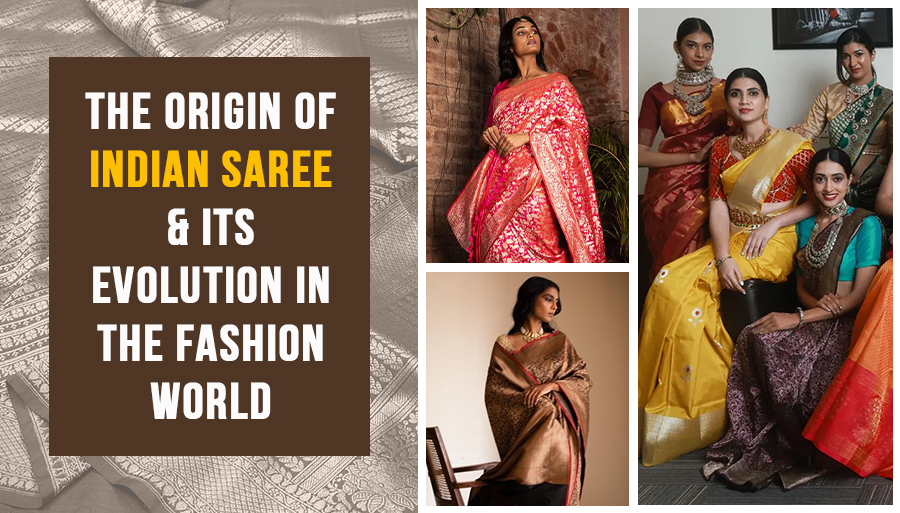Many women have experienced this when they were girls. A young girl watching her mother twist and tuck six yards of silk into perfect pleats and the fabric makes her appear more glamorous than ever. That’s the saree, not just clothing but a legacy stitched into the soul of India. It’s the garment that dances at weddings, stands tall in boardrooms, and even rebels on protest streets. But how did a simple length of cloth become this powerful? From the Indus Valley to Instagram reels, let’s wander through its journey.
Where Cotton Met Civilization

Long before history books began, the saree was already alive. Dig into the ruins of Mohenjo-Daro around 2600 BCE, and what we find a tiny stone statue of a dancer. The statue, is clothed in what looks like a draped shawl, a kind of saree in its earliest form. There are no buttons; it is just the fabric that hugs her body curves. This is why Saree has always been the practical clothing of India. The torching heat and suffocating humidity make ideal conditions for people to find comfort in this breathable clothing. There cannot be anything simpler than a single piece of cloth for clothing, which we call saree.
But here, there is a twist. That so-called simple cloth was a marvel. The most preferred fabric for earliest saree weavers was cotton; India is this crop’s home. Cotton made the colorful saree fabric with turmeric, marigold, and indigo. In the Vedas sarees, we’re called śāṭīka or a strip of cloth, because of the simple and minimalistic nature of this traditional clothing. When her husband’s enemies shame Draupadi in the Indian epic Mahabharata at around 400 BCE, her saree becomes infinite. Isn’t it a metaphor for the divine shield of protection? It shows how deeply the saree was considered a part of woman’s dignity.
Silk, Gold, and the Art of Survival

Now time travel to the Gupta era around 4th century CE. Trade routes that time were buzzing with Chinese silk, Persian silver, and Indian ingenuity. Suddenly, sarees became canvases. Weavers in Varanasi spun gold threads into brocade, creating Banarasi sarees so heavy they could stand alone. Down south, Tamil temple dancers wore sarees dyed with crushed shells and pearls; their pallus, or the border where the drape ends, appeared fluttering like wings.
But the Mughal era brings the most unusual twist to this slow evolution. Persian invaders brought paisley motifs and jasmine flowers, but Indian artisans slyly wove in peacocks and lotus buds. A silent middle finger to the empire. The saree absorbed, adapted, and outlasted.
Colonial Cloth and the Flight of Freedom

Then came the British. Factories in Manchester churned out cheap cotton, starving Indian weavers. But Gandhi turned the saree into a weapon. In the 1920s, he urged women to spin khadi (homespun cloth) on charkhas. Suddenly, every khadi saree was a protest. Sarojini Naidu, the “Nightingale of India,” wore hers while facing British batons. The saree wasn’t just fabric, and it was defiance.
After India’s freedom in 1947, Bollywood glamourized sarees like never before. Think Madhubala in Mughal-e-Azam, wearing her red chiffon saree and singing. In that era, women from all walks of life copied her style and started pinning pallus like their favorite heroine on the silver screen. Yet in villages, grandmothers still folded their cotton sarees like their ancestors did.
A Tour Through Many Varieties of Sarees

Seeing the many regional varieties of sarees across Indian provinces and cities is like a cultural trip. Let’s begin this trip.
· Varanasi, UP: Banarasi weavers work by dim lanterns, threading real gold into sarees that take six months to finish. Each paisley? A prayer.
· Kanchipuram, TN: Brides here wear Kanjeevarams so stiff with silk, they rustle like autumn leaves. The zari border? Often thicker than a rupee coin.
· Bhuj, Gujarat: Bandhani artisans tie millions of tiny knots with fingernails. Unravel one, and the dye reveals sunburst patterns, a metaphor for life’s surprises.
· Assam: Muga silk sarees glow like molten gold. Fun fact: The silk worms here eat aromatic som leaves, giving the fabric a natural sheen no machine can replicate.
Why the Saree Won’t Quit
My aunt, a 65-year-old professor, wears starched cotton sarees to teach physics. “Jeans don’t command respect,” she smirks. Meanwhile, my cousin in Bangalore pairs lehenga-style sarees with Converse sneakers. Critics scoff, but isn’t rebellion in the saree’s DNA?
Designers get it. Sabyasachi revives Jamdani weaves for brides who want vintage but not grandma style. Masaba Gupta slaps neon prints on organza for the Insta generation. Yet, in
Odisha’s villages, illiterate weavers still chant hymns as they thread looms. The saree bends, never breaks.
Beware of the Cheap Synthetic Variants
Sarees are not all glitter, especially when they are factory-made synthetic ones. Handloom saree weavers always earn less than daily wage laborers, and their produce is expensive because of the labor cost. This is why fast fashion is now flooding markets, and sarees remain no exception to this trend of mass-produced fashion.
You can find fake Kanjeevarams made in Chinese factories for below one thousand rupees. But such cheap variants are nothing compared to the original ones. When you buy a real Pochampally ikat, you are not just buying hot fashion; you are saving a craft older than many heritages.
The Final Word
When you wear your mom’s 30-year-old Kanjeevaram to your best friend’s wedding, the old silk glims. Even when the silk has dulled, as you dance, the pallu slips, and the sheen in the fold easily brings out the heritage feel. No wonder traditional Kanjeevaram or Benarasis are still part of family heritage that passes through generations.
Apart from its history and heritage, the saree also establishes a natural connection with the traditional craftsman. It’s a conversation between a weaver’s seasoned hands and your present-day fashion sensibilities. It is also the most original and sustainable fashion from India. And if you’re looking to embrace this legacy, G3+ Fashion brings you a handpicked collection of exquisite sarees that honor this rich tradition. From premium-quality silk sarees to contemporary drapes, the store offers exclusive designs, expert styling advice, and a seamless online shopping experience. With video shopping services, worldwide delivery, and a range of traditional and modern styles, finding your perfect saree has never been easier.

